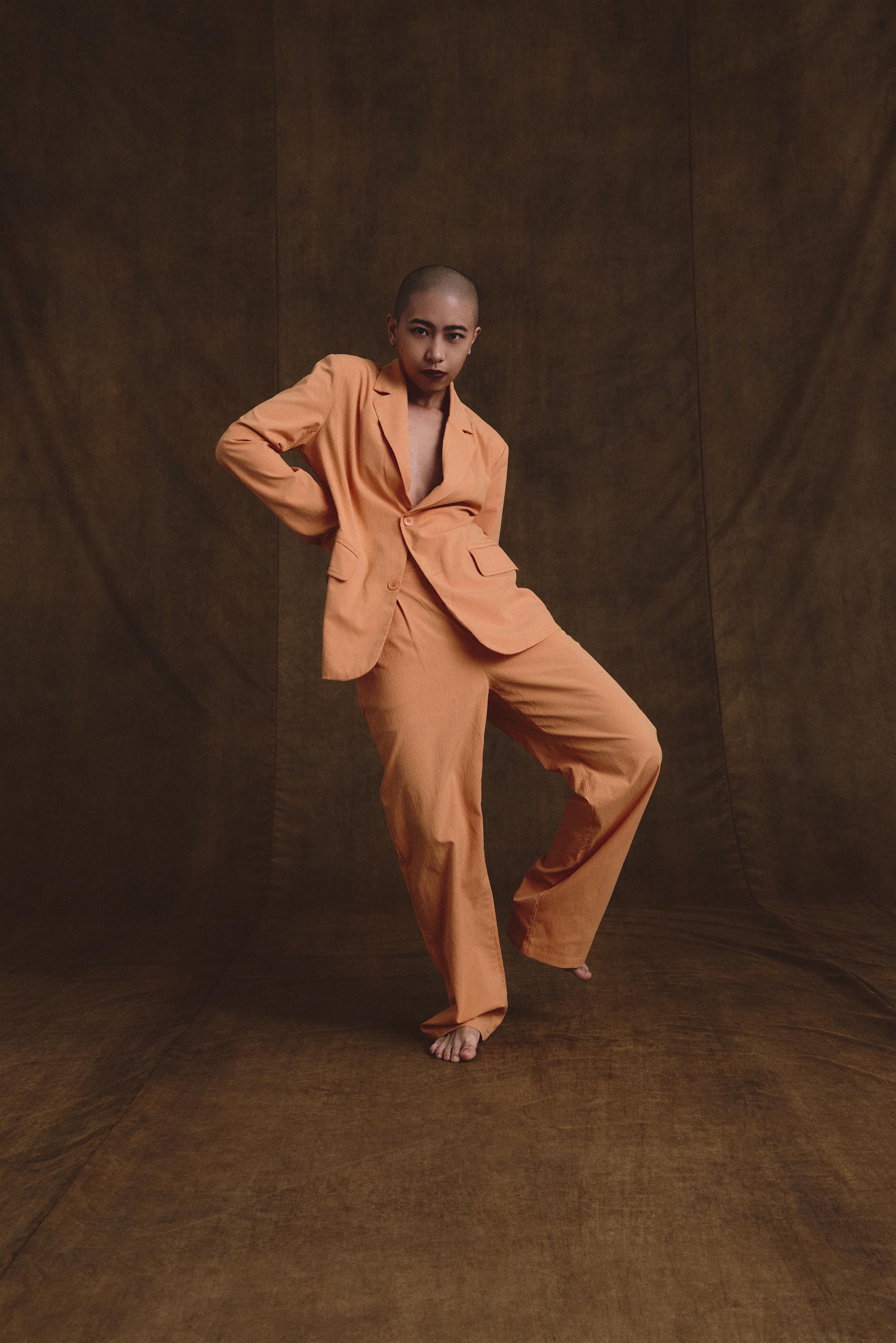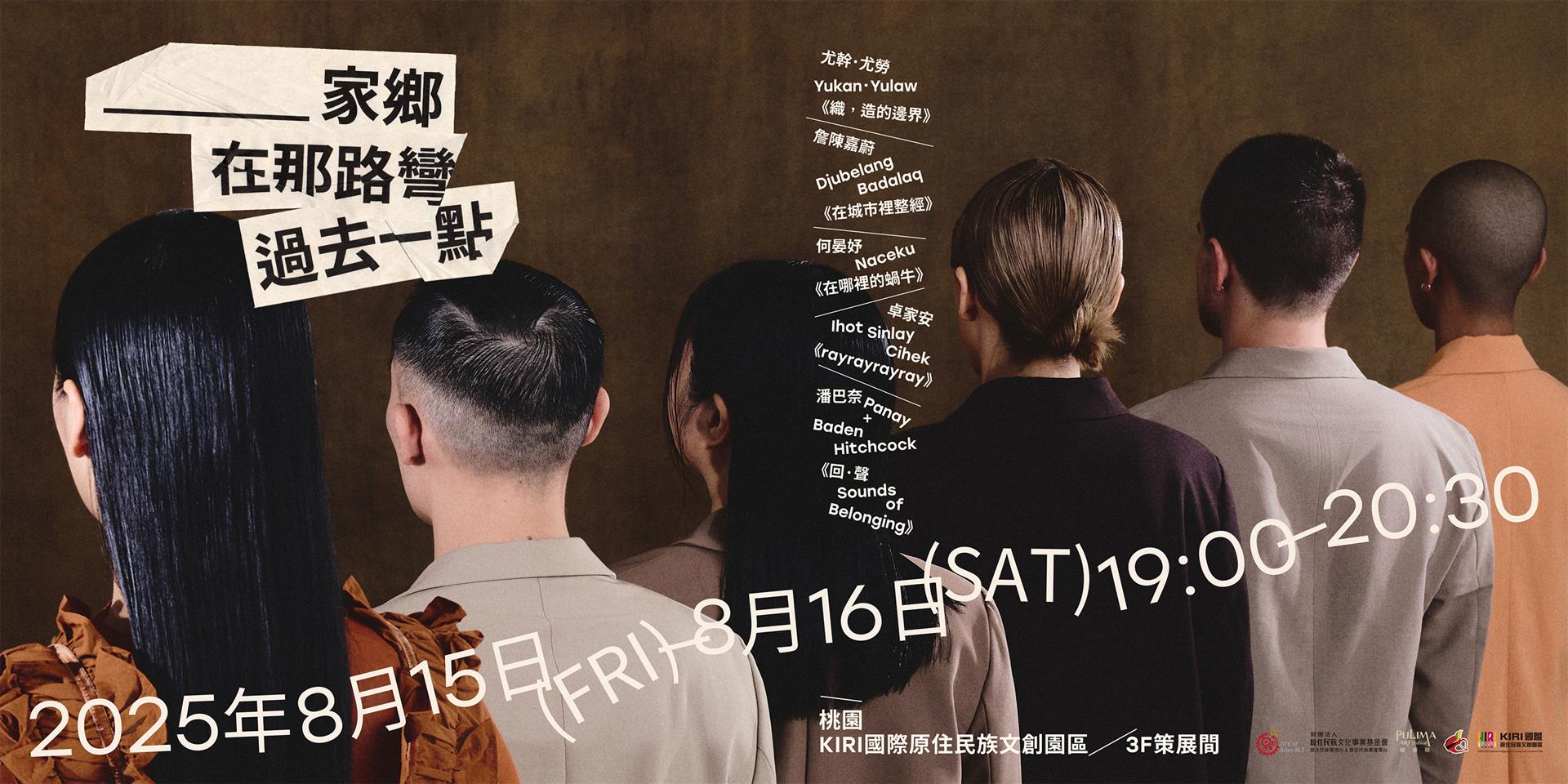創作者介紹|在身體與邊界之間——原漢之身、非二元之舞
卑南族與臺灣漢族裔的表演藝術創作者,現任看嘸舞蹈劇場排練助理,畢業於臺北市立大學舞蹈系。其創作根植於身體實踐,挖掘在多重身份交織下的感知與抵抗經驗,特別關注原住民文化、酷兒文化與非二元性別認同如何在台灣社會中被觀看、被挑戰、被重塑。他藉由當代舞蹈語彙與肢體辯證,持續回應原漢雙族裔身份的複雜處境,並探索多元性別下的身體語言與情感動能。透過作品,他試圖建構一種開放的敘事方式,讓身份不再是框架,而是流動、轉化與連結的力量。
近期作品包括《在哪裡的蝸牛》,入選2023 Pulima藝術獎表演創作徵件競賽,並受邀至加拿大 2024 Toronro Taipei Interlink 開放工作室呈現,2025年亦於草草戲劇節完整演出;《其他日常》則於2024女子馬戲平台展演,持續以舞蹈書寫非典型日常。過去亦曾參與臺北藝術節、臺北詩歌節、「舞蹈南方」嘉義駐地國際交流雙週等演出,並獲選為2025 Perth Moves國際舞蹈工作坊臺灣端參與藝術家。他持續在行動與創作中凝視身體的邊界,並以創作作為介入社會與文化的方式,回應當代的在場與未竟。
節目名稱|《在哪裡的蝸牛》
「在台北的蝸牛,大多時候也會在雨後出沒, 在台北找不太到蝸牛,可能徘徊於他人相互張開雙臂,便會觸碰到的空間, 在台北的蝸牛,通常會被無數快速行駛的車輛輾壓過, 在台北稀釋融化,黏著在悶熱盆地的焦土上, 在台北的蝸牛,大多隱身在鬧區邊緣的草叢裡, 在台北繁殖變異,保持著流動、多重的完整性, 在台北的蝸牛,通常容易迷失在大街小巷, 在台北試圖選擇,選擇以為有選擇的方向。」
晏妤Naceku某次在台北收到mumu(阿嬤)從部落(台東)寄送已去殼處理好的冷凍蝸牛,而寫下上述文字;從小在台北出生成長的他,只有在寒假或暑假,會回到部落與mumu(阿媽)一起在部落採集、料理蝸牛,長大後卻因為工作而無法時常回部落,每當看到冷凍蝸牛,便深感那段參與和連結的缺席,似乎也離自身文化也越來越遠......
以卑南族傳統家常菜餚「炒蝸牛」中雌雄同體的非洲大蝸牛為隱喻,體現作為一位成長於都市,卑南族與台灣漢族裔、非二元性別的身份 ,透過作品探索性別與文化交織下的混種性,回應臺灣多重殖民歷史背景裡,面對身份認同的流動及模糊性,游移不同地域與文化縫隙中的複雜處境。創作中企圖藉由非二元的主張,透過在都市中能連結部落生活的物件,轉換原有的符號意象,創造蝸牛般似人非人的身體樣態,顯露身體裡的文化記憶,聚焦雙重文化身份下的身體政治與經歷,在思辨能動性的過程,擴展建立文化認同的其他可能途徑和生存敘事。
《在哪裡的蝸牛》以三大元素為發展方向
混種現身顯影:以登山包與蝸牛殼作為意象連結,隱喻晏妤Naceku的多重身份,宛如在都市與部落之間游移的蝸牛,既承載身體,也背負著文化與歷史,這樣的存在持續受外在環境的形塑,與他人視角的投射,時而被包容、時而被排斥;透過這一形象,具象地展現都市原住民既屬於也不屬於的生活處境,在身份模糊的縫隙中,形成介於意識與身體感受之間的「混種現身」。
混種的離散經驗:將 mumu寄送的冷凍蝸牛納入作品,象徵都市與部落之間難以穿越的地理、心理與文化距離,作為都市中的原住民,無法即時參與撿拾、料理與共享的過程,這不僅是勞動的缺席,更是對文化實踐的斷裂,冷凍蝸牛成為一種被壓縮與保存的記憶載體,凝結了那些來不及參與的瞬間,在這樣的時間與空間的離散中,晏妤Naceku的身分不斷游移,也映照了在尋找文化認同過程中的遺失與再建構。
混種的世界觀:晏妤Naceku的身體與意識本身即是混種的現場,一種對單一、正統敘事的挑戰,在台灣多重殖民的歷史中,原住民族被長期塑造成靜止的他者,是想像中的物化、是消逝中的文化、是被展示的傳統;然而,在這樣的歷史縫隙中,我們始終活著,並以自己的方式創造著,拒絕被簡化,也無需被歸類。混種的世界觀似乎不以回到某種文化本質為終點,而是在破碎與離散中尋找再生的可能,不再等待被誰定義,而是持續發揮能動性,自我賦權創造屬於自己的敘事,用萬種樣貌書寫解殖民。
Artist Introduction | Between Body and Boundaries — The Dance of Indigenous-Han Identity and Non-Binary
Naceku is a performance artist of Pinuyumayan and Taiwanese Han descent. They are currently the rehearsal assistant at Kua Bo Dance Theatre and a graduate of the Department of Dance at the University of Taipei. Naceku’s artistic practice is nourished by embodied experience, examining the sensory and resistant experiences that emerge from intersecting identities. They focus on how Indigenous culture, queer narratives, and non-binary gender identities are perceived, challenged, and reimagined within Taiwanese society.
Through contemporary dance language and corporeal inquiry, Naceku continuously engages with the complexities of being both Indigenous and Taiwanese Han, while also exploring the expressive potential and emotional intensity of non-binary embodiment. Their work aims to construct an open mode of storytelling, where identity is not a fixed frame but a force of fluidity, transformation, and connection.
Their recent creations include Where Are the Snails, which was nominated for the 2023 Pulima Art Award’s Performance Competition and invited for presentation at the 2024 Toronto Taipei Interlink Open Studio in Canada. It was also performed in full at the 2025 Grasstraw Festival. Another piece, Other, was performed at the 2024 Women Circus Platform. Naceku continues to explore atypical daily experiences through dance.
They have also participated in performances such as the Taipei Arts Festival, Taipei Poetry Festival, and “Dance South.” In 2025, they were selected as one of the participating artists from Taiwan for the Perth Moves international dance workshop. Naceku utilizes creation as an interaction between modern society and culture by focusing on physical boundaries—responding through creation to questions of presence and unresolved aspirations.
Program Title: Where Are the Snails?
“In Taipei, snails come out after the rain,
and it’s hard to find them, for they might wander in the spaces
where people outstretch their arms and almost touch one another.
In Taipei, snails are often crushed by countless speeding vehicles.
They melt and vaguely disappear, clinging to the burnt ground of a humid basin.
In Taipei, snails hide in the bushes along the edges of the city,
where they reproduce and mutate—sustaining a fluid, multifaceted sense of wholeness.
In Taipei, snails often get lost in alleys and avenues.
In Taipei, they try to choose—choosing the direction they think they’ve chosen.”
These phrases were written by Naceku after receiving a package of frozen, shelled snails sent from the village (Taitung) by their mumu (grandmother).
They were born and raised in Taipei and only returned to the village during winter and summer vacations to collect and cook snails with their mumu.
As they grew older, work increasingly kept them away from this experience. Each time Naceku saw the frozen snails, they felt the absence of that shared connection—and a growing distance from their own culture.
In this performance, Naceku uses the African giant snail—a key ingredient in a common Pinuyumayan household dish—as a metaphor.
As a hermaphroditic/androgynous being, the snail reflects their experience as a non-binary person of Pinuyumayan and Taiwanese Han descent, raised in an urban environment.
The performance explores the hybridity shaped by the intersection of gender and cultural identity, responding to their experience of cultural ambiguity and dislocation within Taiwan’s history of multiple colonizations.
Through a non-binary lens, Naceku engages with urban objects that connect to Indigenous life, transforming their original symbolic meanings to construct a snail-like, human-but-not-quite-human bodily form.
Through this body, cultural memory is revealed, focusing on the body politics and lived experience of dual cultural identity.
Through a reflective process on agency, they seek to expand alternative pathways for cultural grounding, recognition, and survival narratives.
Three Key Elements of Where Are the Snails?
Hybrid Appearance:
Using the imagery of a hiking backpack and a snail shell, the work metaphorically expresses the artist’s multiple identities—like a snail navigating between the urban and the ancestral village.
This shell carries not only physical weight but also the burdens of culture and history, continuously shaped by external environments and the projections of others—sometimes embraced, sometimes excluded.
It figuratively represents the condition of urban Indigenous peoples who both belong and do not belong.
In the blurred spaces between identity and bodily perception, a state of “hybrid embodiment” emerges—situated between consciousness and sensation.
Diasporic Experience of Hybridity:
The inclusion of frozen snails sent by mumu (grandmother) symbolizes the geographical, psychological, and cultural distance between city and village.
As an Indigenous person living in the city, the artist is unable to participate in the gathering, cooking, and sharing of snails in real time.
This absence is not merely a lack of labor, but a rupture in cultural practice.
The frozen snails become vessels of compressed and preserved memory—moments never fully lived.
This dispersal across time and space reflects the continuous drifting of identity, mirroring the loss and reconstruction inherent in the search for cultural belonging.
Hybrid Worldview:
The artist’s body and consciousness become a site of hybridity—a challenge to singular, orthodox narratives.
In Taiwan’s colonial history, Indigenous peoples have long been cast as static others: as objectified imaginings, fading cultures, or traditional relics on display.
Yet within these historical fissures, the artist and others like them have always been living and creating in their own ways—refusing simplification, resisting classification.
A hybrid worldview does not aim to return to a singular cultural essence; rather, it finds renewal in fragmentation and dispersal.
No longer waiting to be defined, the artist acts with agency, empowered to write decolonial narratives through multiple forms and identities.
延伸閱讀:
➤ 專訪|何晏妤 Naceku
卑南族與臺灣漢族裔的表演藝術創作者,現任看嘸舞蹈劇場排練助理,畢業於臺北市立大學舞蹈系。其創作根植於身體實踐,挖掘在多重身份交織下的感知與抵抗經驗,特別關注原住民文化、酷兒文化與非二元性別認同如何在台灣社會中被觀看、被挑戰、被重塑。他藉由當代舞蹈語彙與肢體辯證,持續回應原漢雙族裔身份的複雜處境,並探索多元性別下的身體語言與情感動能。透過作品,他試圖建構一種開放的敘事方式,讓身份不再是框架,而是流動、轉化與連結的力量。
近期作品包括《在哪裡的蝸牛》,入選2023 Pulima藝術獎表演創作徵件競賽,並受邀至加拿大 2024 Toronro Taipei Interlink 開放工作室呈現,2025年亦於草草戲劇節完整演出;《其他日常》則於2024女子馬戲平台展演,持續以舞蹈書寫非典型日常。過去亦曾參與臺北藝術節、臺北詩歌節、「舞蹈南方」嘉義駐地國際交流雙週等演出,並獲選為2025 Perth Moves國際舞蹈工作坊臺灣端參與藝術家。他持續在行動與創作中凝視身體的邊界,並以創作作為介入社會與文化的方式,回應當代的在場與未竟。
節目名稱|《在哪裡的蝸牛》
「在台北的蝸牛,大多時候也會在雨後出沒, 在台北找不太到蝸牛,可能徘徊於他人相互張開雙臂,便會觸碰到的空間, 在台北的蝸牛,通常會被無數快速行駛的車輛輾壓過, 在台北稀釋融化,黏著在悶熱盆地的焦土上, 在台北的蝸牛,大多隱身在鬧區邊緣的草叢裡, 在台北繁殖變異,保持著流動、多重的完整性, 在台北的蝸牛,通常容易迷失在大街小巷, 在台北試圖選擇,選擇以為有選擇的方向。」
晏妤Naceku某次在台北收到mumu(阿嬤)從部落(台東)寄送已去殼處理好的冷凍蝸牛,而寫下上述文字;從小在台北出生成長的他,只有在寒假或暑假,會回到部落與mumu(阿媽)一起在部落採集、料理蝸牛,長大後卻因為工作而無法時常回部落,每當看到冷凍蝸牛,便深感那段參與和連結的缺席,似乎也離自身文化也越來越遠......
以卑南族傳統家常菜餚「炒蝸牛」中雌雄同體的非洲大蝸牛為隱喻,體現作為一位成長於都市,卑南族與台灣漢族裔、非二元性別的身份 ,透過作品探索性別與文化交織下的混種性,回應臺灣多重殖民歷史背景裡,面對身份認同的流動及模糊性,游移不同地域與文化縫隙中的複雜處境。創作中企圖藉由非二元的主張,透過在都市中能連結部落生活的物件,轉換原有的符號意象,創造蝸牛般似人非人的身體樣態,顯露身體裡的文化記憶,聚焦雙重文化身份下的身體政治與經歷,在思辨能動性的過程,擴展建立文化認同的其他可能途徑和生存敘事。
《在哪裡的蝸牛》以三大元素為發展方向
混種現身顯影:以登山包與蝸牛殼作為意象連結,隱喻晏妤Naceku的多重身份,宛如在都市與部落之間游移的蝸牛,既承載身體,也背負著文化與歷史,這樣的存在持續受外在環境的形塑,與他人視角的投射,時而被包容、時而被排斥;透過這一形象,具象地展現都市原住民既屬於也不屬於的生活處境,在身份模糊的縫隙中,形成介於意識與身體感受之間的「混種現身」。
混種的離散經驗:將 mumu寄送的冷凍蝸牛納入作品,象徵都市與部落之間難以穿越的地理、心理與文化距離,作為都市中的原住民,無法即時參與撿拾、料理與共享的過程,這不僅是勞動的缺席,更是對文化實踐的斷裂,冷凍蝸牛成為一種被壓縮與保存的記憶載體,凝結了那些來不及參與的瞬間,在這樣的時間與空間的離散中,晏妤Naceku的身分不斷游移,也映照了在尋找文化認同過程中的遺失與再建構。
混種的世界觀:晏妤Naceku的身體與意識本身即是混種的現場,一種對單一、正統敘事的挑戰,在台灣多重殖民的歷史中,原住民族被長期塑造成靜止的他者,是想像中的物化、是消逝中的文化、是被展示的傳統;然而,在這樣的歷史縫隙中,我們始終活著,並以自己的方式創造著,拒絕被簡化,也無需被歸類。混種的世界觀似乎不以回到某種文化本質為終點,而是在破碎與離散中尋找再生的可能,不再等待被誰定義,而是持續發揮能動性,自我賦權創造屬於自己的敘事,用萬種樣貌書寫解殖民。
Artist Introduction | Between Body and Boundaries — The Dance of Indigenous-Han Identity and Non-Binary
Naceku is a performance artist of Pinuyumayan and Taiwanese Han descent. They are currently the rehearsal assistant at Kua Bo Dance Theatre and a graduate of the Department of Dance at the University of Taipei. Naceku’s artistic practice is nourished by embodied experience, examining the sensory and resistant experiences that emerge from intersecting identities. They focus on how Indigenous culture, queer narratives, and non-binary gender identities are perceived, challenged, and reimagined within Taiwanese society.
Through contemporary dance language and corporeal inquiry, Naceku continuously engages with the complexities of being both Indigenous and Taiwanese Han, while also exploring the expressive potential and emotional intensity of non-binary embodiment. Their work aims to construct an open mode of storytelling, where identity is not a fixed frame but a force of fluidity, transformation, and connection.
Their recent creations include Where Are the Snails, which was nominated for the 2023 Pulima Art Award’s Performance Competition and invited for presentation at the 2024 Toronto Taipei Interlink Open Studio in Canada. It was also performed in full at the 2025 Grasstraw Festival. Another piece, Other, was performed at the 2024 Women Circus Platform. Naceku continues to explore atypical daily experiences through dance.
They have also participated in performances such as the Taipei Arts Festival, Taipei Poetry Festival, and “Dance South.” In 2025, they were selected as one of the participating artists from Taiwan for the Perth Moves international dance workshop. Naceku utilizes creation as an interaction between modern society and culture by focusing on physical boundaries—responding through creation to questions of presence and unresolved aspirations.
Program Title: Where Are the Snails?
“In Taipei, snails come out after the rain,
and it’s hard to find them, for they might wander in the spaces
where people outstretch their arms and almost touch one another.
In Taipei, snails are often crushed by countless speeding vehicles.
They melt and vaguely disappear, clinging to the burnt ground of a humid basin.
In Taipei, snails hide in the bushes along the edges of the city,
where they reproduce and mutate—sustaining a fluid, multifaceted sense of wholeness.
In Taipei, snails often get lost in alleys and avenues.
In Taipei, they try to choose—choosing the direction they think they’ve chosen.”
These phrases were written by Naceku after receiving a package of frozen, shelled snails sent from the village (Taitung) by their mumu (grandmother).
They were born and raised in Taipei and only returned to the village during winter and summer vacations to collect and cook snails with their mumu.
As they grew older, work increasingly kept them away from this experience. Each time Naceku saw the frozen snails, they felt the absence of that shared connection—and a growing distance from their own culture.
In this performance, Naceku uses the African giant snail—a key ingredient in a common Pinuyumayan household dish—as a metaphor.
As a hermaphroditic/androgynous being, the snail reflects their experience as a non-binary person of Pinuyumayan and Taiwanese Han descent, raised in an urban environment.
The performance explores the hybridity shaped by the intersection of gender and cultural identity, responding to their experience of cultural ambiguity and dislocation within Taiwan’s history of multiple colonizations.
Through a non-binary lens, Naceku engages with urban objects that connect to Indigenous life, transforming their original symbolic meanings to construct a snail-like, human-but-not-quite-human bodily form.
Through this body, cultural memory is revealed, focusing on the body politics and lived experience of dual cultural identity.
Through a reflective process on agency, they seek to expand alternative pathways for cultural grounding, recognition, and survival narratives.
Three Key Elements of Where Are the Snails?
Hybrid Appearance:
Using the imagery of a hiking backpack and a snail shell, the work metaphorically expresses the artist’s multiple identities—like a snail navigating between the urban and the ancestral village.
This shell carries not only physical weight but also the burdens of culture and history, continuously shaped by external environments and the projections of others—sometimes embraced, sometimes excluded.
It figuratively represents the condition of urban Indigenous peoples who both belong and do not belong.
In the blurred spaces between identity and bodily perception, a state of “hybrid embodiment” emerges—situated between consciousness and sensation.
Diasporic Experience of Hybridity:
The inclusion of frozen snails sent by mumu (grandmother) symbolizes the geographical, psychological, and cultural distance between city and village.
As an Indigenous person living in the city, the artist is unable to participate in the gathering, cooking, and sharing of snails in real time.
This absence is not merely a lack of labor, but a rupture in cultural practice.
The frozen snails become vessels of compressed and preserved memory—moments never fully lived.
This dispersal across time and space reflects the continuous drifting of identity, mirroring the loss and reconstruction inherent in the search for cultural belonging.
Hybrid Worldview:
The artist’s body and consciousness become a site of hybridity—a challenge to singular, orthodox narratives.
In Taiwan’s colonial history, Indigenous peoples have long been cast as static others: as objectified imaginings, fading cultures, or traditional relics on display.
Yet within these historical fissures, the artist and others like them have always been living and creating in their own ways—refusing simplification, resisting classification.
A hybrid worldview does not aim to return to a singular cultural essence; rather, it finds renewal in fragmentation and dispersal.
No longer waiting to be defined, the artist acts with agency, empowered to write decolonial narratives through multiple forms and identities.
延伸閱讀:
➤ 專訪|何晏妤 Naceku



